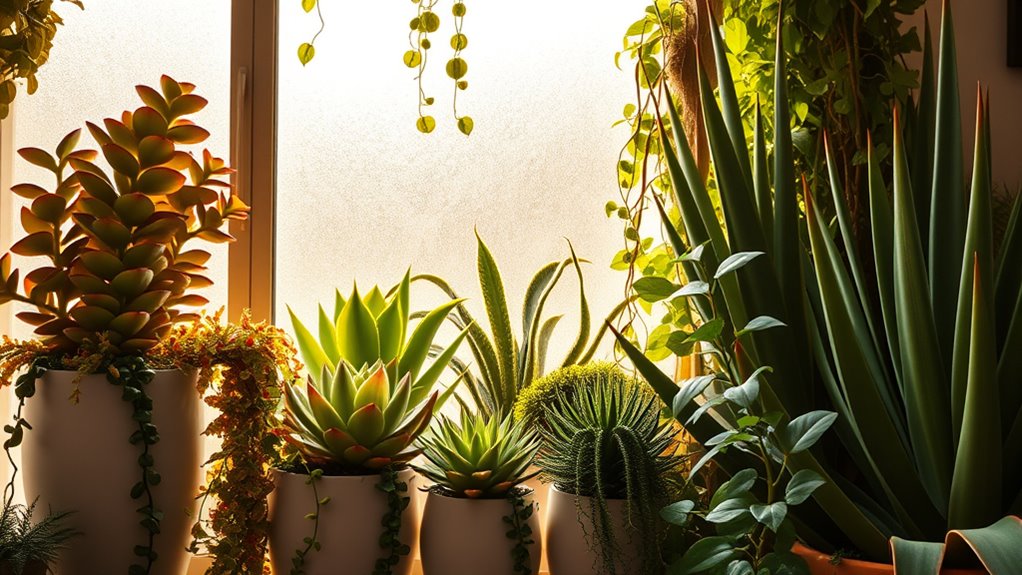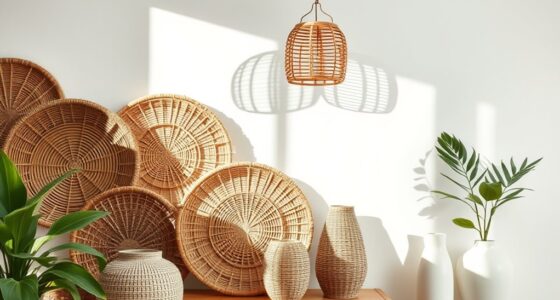To create a heat-tolerant indoor jungle, choose resilient plants like succulents, pothos, and snake plants that handle higher temperatures and dry conditions. Optimize your space by managing temperature with fans or AC, grouping plants for microclimates, and avoiding direct sunlight during hottest hours. Use proper watering techniques, well-draining soil, and humidity boosts to prevent common issues. Keep exploring to discover tips that will help your indoor jungle thrive in warmer environments.
Key Takeaways
- Choose heat-tolerant indoor plants like succulents, pothos, and snake plants for resilient indoor jungles.
- Optimize indoor conditions with fans, humidifiers, and strategic placement away from direct sunlight.
- Water only when soil is dry, use well-draining pots, and increase humidity to prevent heat stress.
- Enhance moisture retention with organic soil amendments, mulch, and self-watering containers.
- Use tools like moisture meters, pruning shears, and insecticidal soap for effective plant maintenance.
The Rise of Heat-Resilient Indoor Plants
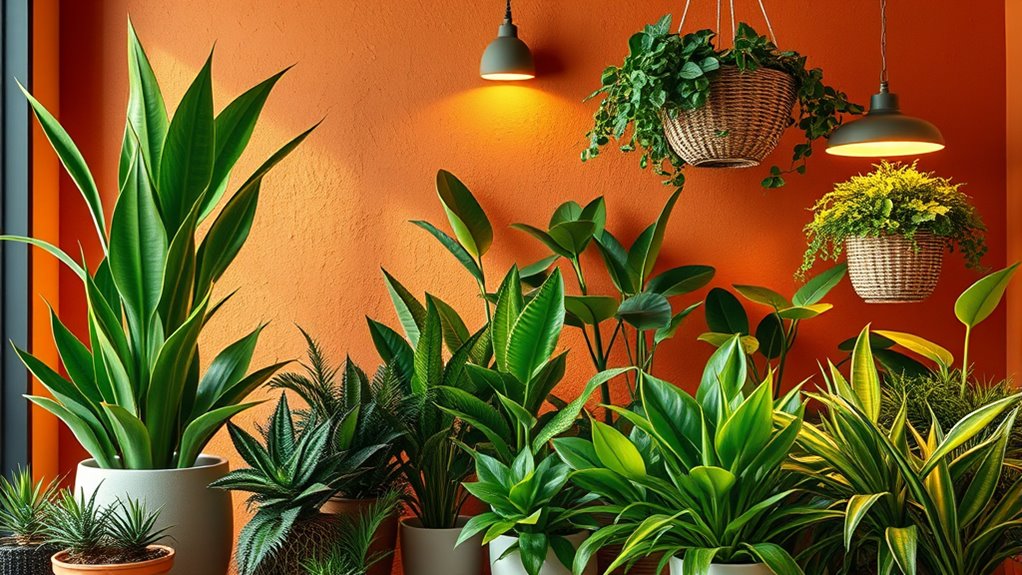
As indoor temperatures become more unpredictable, heat-resilient plants are gaining popularity among plant parents. You’re looking for greenery that can thrive despite temperature swings and dry spells. These plants are naturally equipped to handle higher heat levels, making them perfect for homes with inconsistent climate control or sunny spots. They require less fuss and fewer special care routines, so you spend less time worrying about temperature fluctuations harming your plants. Popular options include succulents, cacti, and certain tropical species like pothos and snake plants, which have adapted to withstand heat stress. Their resilience keeps your indoor jungle vibrant and healthy, even when the weather outside shifts unpredictably. Additionally, advancements in heat pump technology are making it easier to maintain optimal indoor temperatures, further supporting the health of these hardy plants. Recognizing the importance of global entertainment industry is also influencing the design of aesthetically pleasing and sustainable indoor environments. Incorporating plant resilience into your selection process ensures your indoor jungle remains thriving regardless of climate challenges. Moreover, understanding personal development techniques like visualizations can help you stay motivated and consistent in your plant care routine, ensuring your indoor garden flourishes over time. This awareness can also motivate you to explore innovative indoor gardening methods that boost plant health and longevity.
Choosing the Right Heat-Tolerant Species
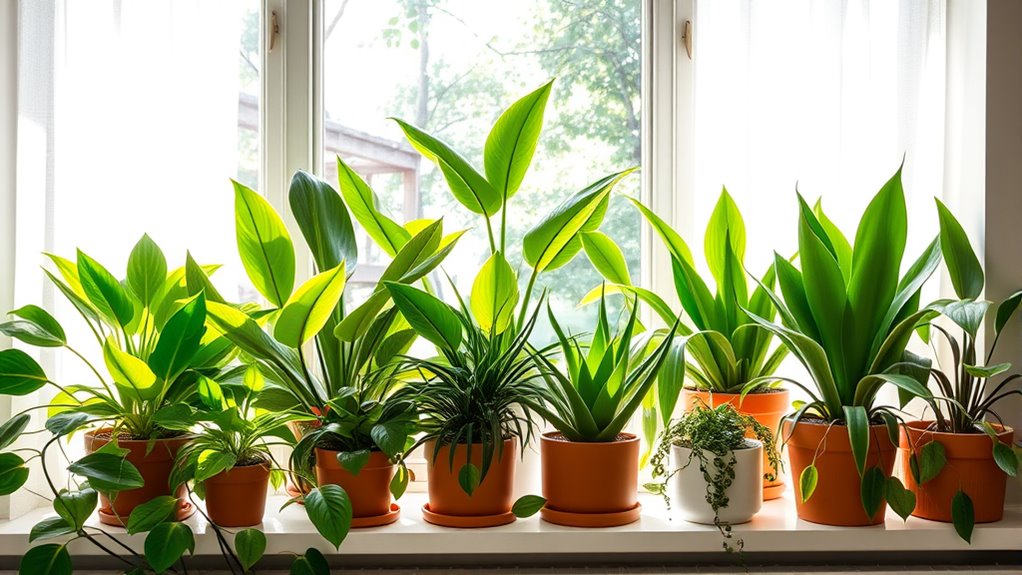
Choosing the right heat-tolerant species means understanding which plants can handle your specific indoor environment. Consider your space’s temperature range, light levels, and humidity before selecting plants. Look for species known for their resilience in warmer conditions, like snake plants, pothos, or zz plants. These plants thrive with less frequent watering and can tolerate higher temperatures without stress. Avoid delicate varieties that wilt or show signs of heat stress easily. Research each plant’s natural habitat to ensure it aligns with your indoor climate. Additionally, choosing plants with heat-resistant foliage can further enhance your indoor jungle’s resilience and visual appeal. Understanding the plant’s natural habitat helps you select appropriate heat-tolerant species, ensuring your indoor jungle stays healthy, vibrant, and low-maintenance despite warmer conditions. Incorporating hardy indoor plants can also reduce the need for frequent care and create a thriving indoor jungle.
Essential Care Tips for Hotter Climates
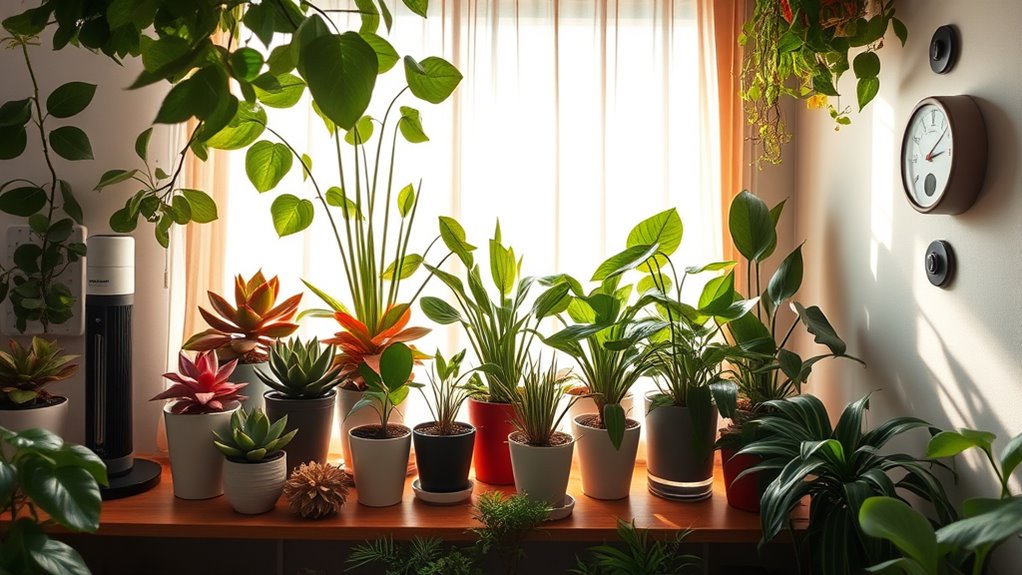
When caring for indoor jungle plants in hotter climates, maintaining proper watering practices is essential. You should water only when the top inch of soil feels dry to prevent overwatering, which can lead to root rot. During heatwaves, your plants might need more frequent watering, but always check soil moisture first. Use room-temperature water to avoid shocking the roots. Confirm your pots have drainage holes to let excess water escape and prevent water from sitting at the bottom. Keep humidity levels higher by misting your plants regularly or placing a tray of water nearby, which helps plants tolerate heat better. Avoid direct sunlight during the hottest part of the day, as intense sun can increase evaporation and stress your plants. Proper watering and humidity are key to thriving indoor jungles in hot climates. Additionally, understanding gold investment strategies can help diversify your financial portfolio, especially in uncertain economic conditions.
Innovative Soil and Watering Techniques
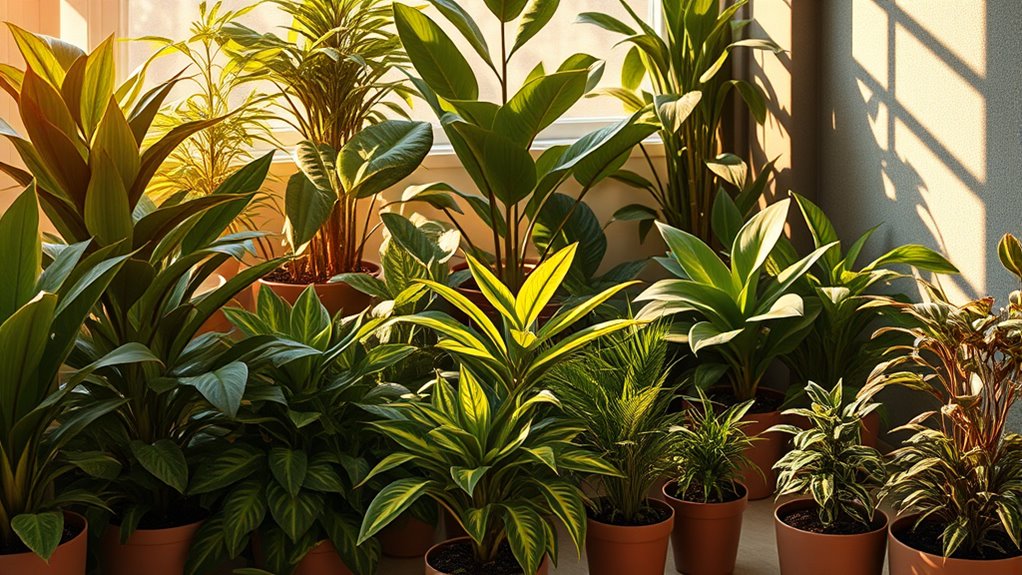
To keep your plants happy, exploring moisture retention strategies can make a big difference. Adjusting soil composition helps conserve water longer and improves overall health. By optimizing these techniques, you’ll ensure your indoor jungle stays lush and vibrant. For example, incorporating efficient watering methods can further enhance water retention and reduce maintenance efforts. Additionally, selecting sustainable plant care practices can minimize environmental impacts and promote healthier growth. Being mindful of angel numbers and their messages can also inspire new approaches to nurturing your plants and environment, fostering a more connected and intuitive plant-parenting experience. Incorporating soil amendments, like organic matter or moisture-retaining gels, can also significantly boost water conservation and plant vitality. Exploring modern gardening tools such as self-watering planters or moisture sensors can further streamline plant care routines and improve plant health.
Moisture Retention Strategies
Innovative soil and watering techniques can substantially improve moisture retention for your indoor jungle plants, ensuring they stay healthy and vibrant. Use self-watering pots to provide a steady water supply, reducing your need for frequent watering and preventing dehydration. Mulching with organic materials like bark or coconut husk helps lock in moisture, keeping roots moist longer. Consider watering deeply and less often to encourage roots to grow downward and develop resilience. Incorporate moisture-retaining amendments such as coconut coir or perlite into your soil mix to improve water retention. Additionally, mist your plants regularly or use humidity trays to maintain consistent moisture levels in the air. These strategies collectively help your heat-tolerant indoor jungle thrive in dry environments, minimizing stress from inconsistent watering.
Soil Composition Optimization
Optimizing soil composition enhances moisture retention and promotes healthy root development for your indoor jungle plants. To achieve this, use a well-balanced mix of organic matter, such as compost or peat moss, combined with inorganic components like perlite or coarse sand. This blend ensures good drainage while holding enough moisture for your plants to thrive. Avoid heavy soils that retain too much water, risking root rot, or overly sandy soils that drain too quickly, causing dehydration. Incorporate slow-release fertilizers into the soil for sustained nutrition. Adjust your soil mix based on each plant’s needs, especially for heat-tolerant varieties. Regularly check soil moisture levels and amend your mixture as necessary to maintain ideal conditions. Proper soil composition is key to establishing a resilient, vibrant indoor jungle. Sound science suggests that understanding soil properties can significantly improve plant health and growth, especially when considering soil aeration and water retention capabilities.
Designing Your Indoor Jungle for Heat Adaptation
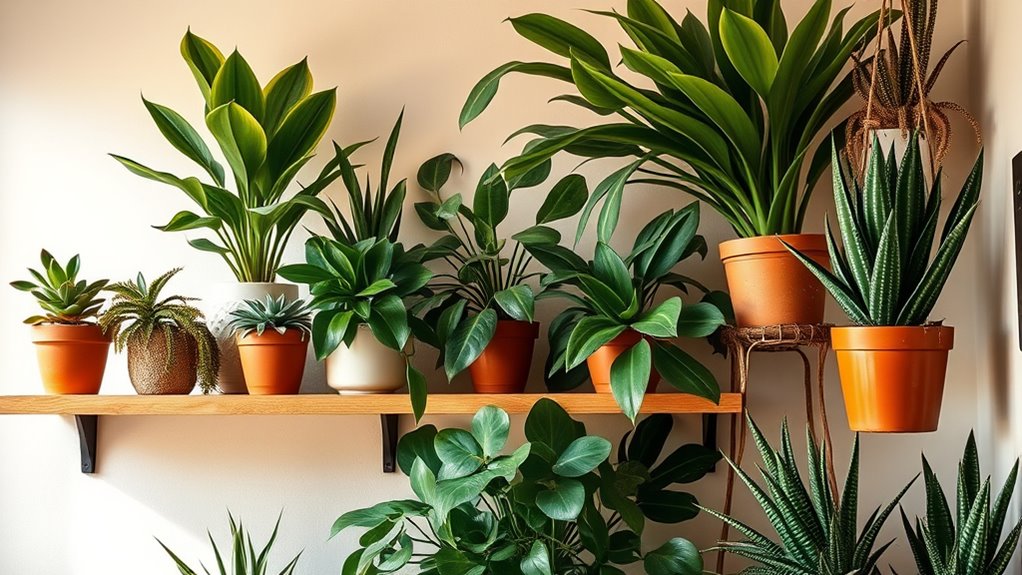
To help your indoor jungle thrive in heat, start by choosing heat-resilient plants that can handle higher temperatures. Then, optimize your indoor climate with proper ventilation and lighting, and place your plants strategically to avoid direct sunlight and heat sources. These steps will guarantee your plants stay healthy and vibrant despite warmer conditions. Incorporating heat-tolerant plants can also enhance your understanding of plant behavior and improve your caregiving approach. Additionally, exploring remote hackathons can be a creative way to develop innovative solutions for sustainable gardening practices and climate adaptation in urban environments. Understanding plant physiology can further inform your strategies for maintaining healthy indoor greenery. Embracing the wisdom of visionaries and leaders can inspire new strategies for resilient gardening and urban planning.
Selecting Heat-Resilient Plants
When designing your indoor jungle for heat resilience, choosing plants that thrive in higher temperatures is essential. Look for species known for their heat tolerance, such as succulents, cacti, and certain tropical plants like pothos or snake plants. These plants have adapted to withstand warmer conditions and will perform well without constant cooling. Avoid delicate or shade-loving plants that struggle in direct sunlight or high heat, like certain ferns or orchids. Consider their water needs too; heat-tolerant plants often require less frequent watering, reducing stress during hot periods. Selecting the right plants now ensures your jungle remains lush and healthy, even when indoor temperatures rise. Prioritize hardy varieties to build a resilient, thriving indoor garden that can handle the heat.
Optimizing Indoor Climate
Creating a comfortable indoor climate for your jungle involves more than just selecting heat-tolerant plants. You need to manage temperature, humidity, and airflow actively. Keep your indoor space cool by using fans or air conditioning during hot days, ensuring temperatures stay within your plants’ tolerance range. Humidity levels matter too—most heat-tolerant plants thrive in moderate to high humidity, so consider using a humidifier or grouping plants together to create a microenvironment. Proper ventilation prevents stagnant air and reduces heat buildup. Avoid placing plants near direct sunlight or heat sources like radiators. Consistent monitoring with a thermometer and hygrometer helps you adjust conditions promptly, maintaining a stable environment that supports your jungle’s health and resilience against heat stress.
Strategic Placement Techniques
Strategic positioning is key to helping your indoor jungle thrive in warm conditions. To combat heat, position plants away from direct sunlight, especially during peak hours, to prevent scorched leaves. Use sheer curtains or place plants in bright, indirect light areas like north-facing windows. Group heat-tolerant plants together, creating microclimates that retain moisture and stay cooler. Elevate plants off hot floors or radiators to prevent overheating. Rotate and rearrange your jungle periodically to ensure even light exposure and prevent stress. Avoid placing plants near heating vents or appliances that generate excess heat. Proper placement not only reduces heat stress but also promotes healthy growth, ensuring your indoor jungle remains vibrant and resilient despite high temperatures.
Common Challenges and How to Overcome Them
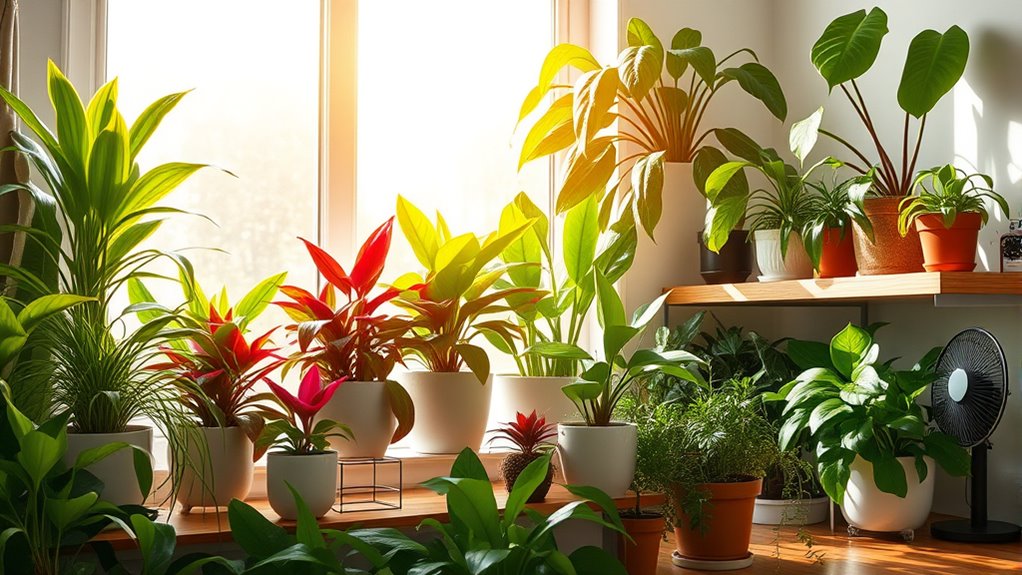
Indoor jungle plant parenting can come with its share of hurdles, but understanding common challenges helps you address them effectively. One frequent issue is overwatering, which can lead to root rot; make certain you check soil moisture before watering and use well-draining pots. Underwatering is another problem, causing plants to wilt; establish a consistent watering schedule based on each plant’s needs. Low humidity or inadequate light can stunt growth, so place plants near windows or use grow lights if natural light is limited. Pests like spider mites or aphids may appear; treat infestations promptly with gentle insecticidal soap. Finally, temperature fluctuations or drafts can stress plants, so keep your jungle in a stable, heat-tolerant environment. Recognizing these challenges helps you maintain a thriving indoor jungle.
Best Tools and Accessories for Maintenance
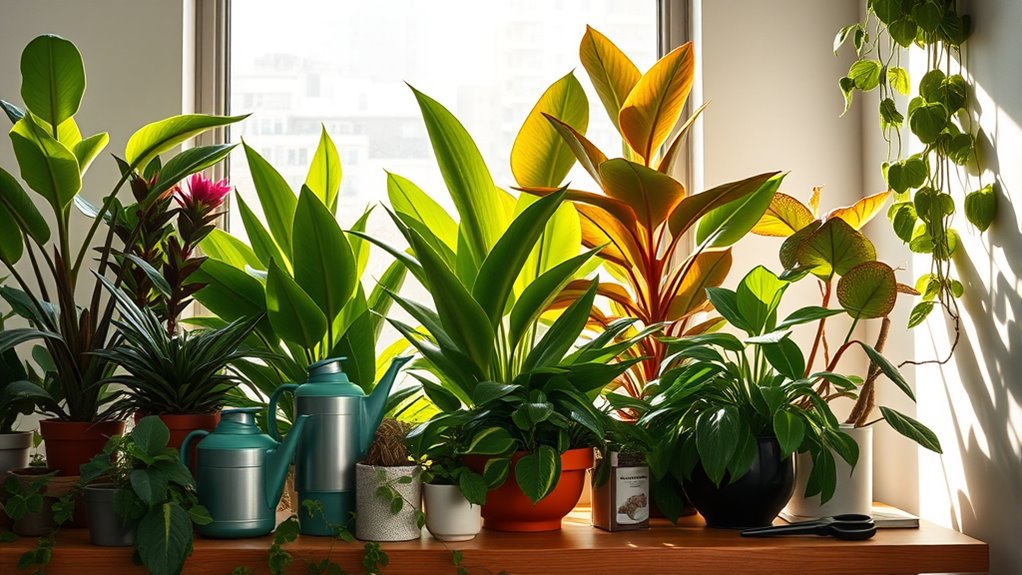
Maintaining a thriving jungle requires having the right tools and accessories on hand. A pair of sharp pruning shears is essential for trimming dead or damaged leaves, promoting healthy growth. A spray bottle helps you maintain humidity and keep foliage dust-free, especially in dry environments. Investing in a moisture meter allows you to monitor soil moisture levels accurately, preventing over- or under-watering. A small watering can with a narrow spout offers precise watering without mess. For pest control, keep a gentle insecticidal soap or neem oil nearby to address issues quickly. Additionally, a soft brush can remove dust from leaves, enhancing photosynthesis. These tools streamline maintenance, keeping your heat-tolerant jungle vibrant, healthy, and ready to thrive indoors.
Inspiring Indoor Jungle Transformations
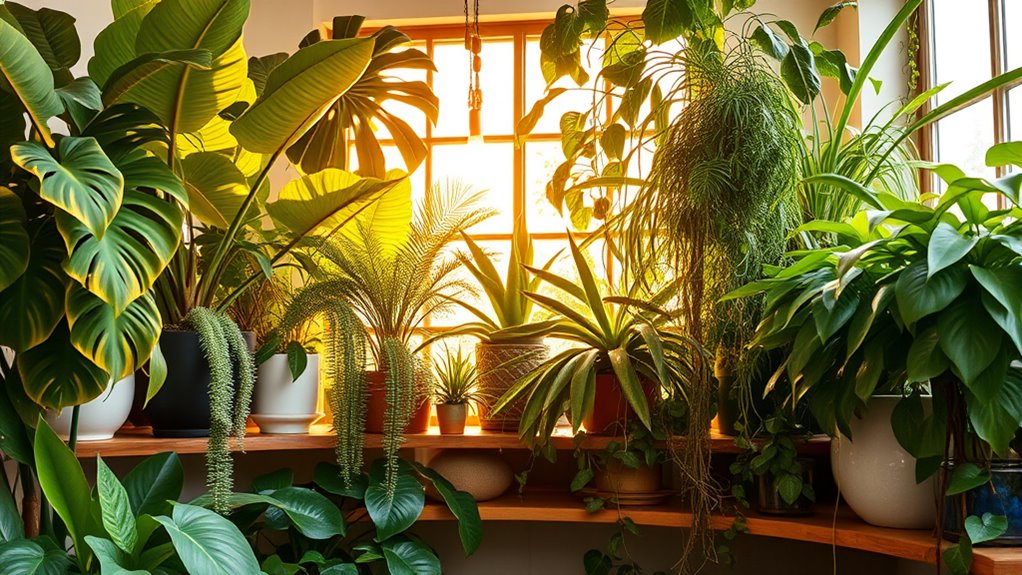
Transforming your space into a lush jungle can turn a dull room into a vibrant oasis. Imagine vibrant green walls, cascading plants, and a cozy atmosphere that invites you to relax. To inspire your transformation, consider these ideas:
Transform your space into a vibrant, lush oasis with cascading plants and cozy, green walls.
- Create a vertical garden by mounting planters on the wall, maximizing space and adding visual interest.
- Choose a focal point like a tall, statement plant that draws the eye and anchors your jungle vibe.
- Incorporate varied textures and heights to add depth—mix hanging plants, floor plants, and tabletop greenery.
These simple steps help you craft a stunning indoor jungle that feels personal and lively. With a little creativity and the right plants, your space can become a thriving green sanctuary.
Frequently Asked Questions
How Can I Identify Heat-Tolerant Plants Suitable for My Space?
To identify heat-tolerant plants for your space, start by researching species known for thriving in high temperatures and direct sunlight. Look for plants labeled as drought-tolerant or heat-resistant, like succulents and certain tropical varieties. Observe their growth habits and leaf textures—thicker, leathery leaves often indicate heat tolerance. Choose plants suited to your indoor environment, ensuring they can handle your home’s temperature and lighting conditions.
What Are the Signs My Indoor Plants Are Suffering From Heat Stress?
When your indoor plants show signs of heat stress, you’ll notice wilting, drooping leaves, or yellowing edges. They might also develop browning or crispy tips, indicating dehydration. If the leaves are shedding or look scorched, it’s a clear sign they’re struggling with high temperatures. You should move them to a cooler spot, increase watering, and make certain they’re not exposed to direct, harsh sunlight for extended periods.
Can Heat-Tolerant Plants Improve Indoor Air Quality?
You might think only air purifiers improve indoor air quality, but heat-tolerant plants do too. They actively filter pollutants like formaldehyde and benzene, enhancing your home’s air. While some believe plants need perfect conditions, heat-tolerant varieties thrive in warmer spots and still purify the air effectively. So, incorporating these plants not only adds greenery but also creates a healthier indoor environment, especially during hot weather.
How Do I Prevent Pests in a Hot Indoor Environment?
To prevent pests in a hot indoor environment, you need to stay vigilant and maintain plant health. Regularly inspect your plants for signs of pests, and remove any affected leaves immediately. Keep humidity levels balanced, as overly humid conditions attract pests. Water plants properly without overwatering, and ensure good air circulation. Using natural repellents like neem oil can also help keep pests at bay, guaranteeing your indoor jungle stays healthy.
Are There Specific Lighting Requirements for Heat-Resilient Indoor Jungles?
Think of your indoor jungle as a sunlit dance floor—lighting is key! For heat-tolerant plants, you’ll want bright, indirect light, mimicking their natural environment. Place them near east or south-facing windows, or use grow lights if sunlight’s limited. Keep the light consistent, around 12-16 hours daily, to promote healthy growth. This way, your jungle will thrive, resilient and radiant, even in the hottest rooms.
Conclusion
As you embrace heat-tolerant indoor jungles, remember that adaptability is key. For example, imagine transforming a sun-drenched corner into a lush oasis using resilient plants like succulents and pothos, combined with innovative watering techniques. With the right choices and care, you’ll create a thriving, vibrant space that withstands higher temperatures. Your indoor jungle isn’t just a decor; it’s a resilient haven that reflects your creativity and adaptability in any climate.
